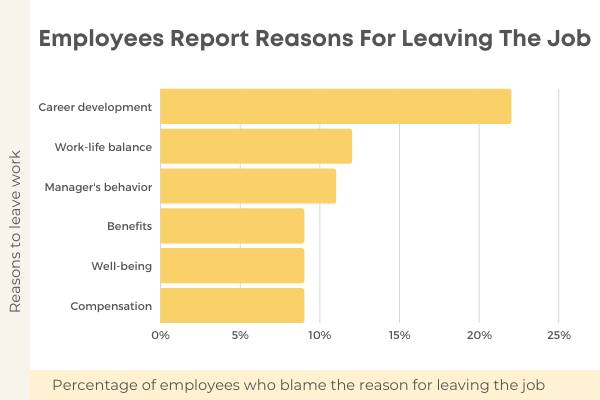Human resources management oversees all the recruiting, interviewing, and hiring functions of a company.
And with the help of human resource management statistics, both managers and leaders can learn how to keep improving the HR department and the company, as well.
As it is important to give employees a positive experience at work, managers can learn a thing or two with the help of these statistics.
Let’s have a look at them, then!
Key Human Resource Management Statistics (Editor’s Pick)
- The HR management market has a value of $19.38 billion.
- Employee retention is the biggest problem for 47% of HR teams.
- 27% of employees leave work voluntarily every year.
- 81% of employees leave their jobs due to job characteristics.
16 Human Resource Management Statistics
1. In 2021, the value of the human resource management market is $19.38 billion.
In 2021, the human resource management market had a value of $19.38 billion, according to Grand View Research. Moreover, it is estimated to have a revenue of $43.29 billion by 2028.
Source: Grand View Research
2. Almost half of the HR teams (47%) say their biggest challenge is employee retention and turnover.
According to the Work Institute Retention Report 2019, 47% of HR teams struggle the most with employee retention and turnover. Moreover, recruitment and corporate culture management are also in the top three challenges.
Source: Work Institute Retention Report 2019
3. More than five in 10 executives expect their employees to work from home one day a week.
Ever since the start of the pandemic, many businesses had to send most of all of their employees to work from home. As it turns out, 55% of executives expect their workers to work from home one day a week after the pandemic. In comparison, before the pandemic, only 39% of executives expected their employees to work from home one day every week.
Source: PwC


4. Almost one in three workers want to continue working from home five days a week after the pandemic.
Around 32% of employees say they want to continue working from home five days a week after the pandemic, according to a PwC survey. Also, 9% want to do it four days a week and 17% three days a week. Furthermore, 15% want to work from home two days a week and 11% one day a week. Finally, 17% say they want to work in the office full-time or most of the time.
Source: PwC
5. Around 87% of employees take part in lifestyle management programs.
Lifestyle management programs such as those that focus on smoking and obesity are run by human resources. Moreover, 87% of employees take part in such lifestyle programs. As a result, they saved employees around $6 a month, and employers around $0.5 a month.
Source: Rand Corporation
6. Around 27% of employees leave their jobs voluntarily every year.
Every year, across all industries, more than a quarter of employees (27%) leave their jobs voluntarily. These data statistics come from a Work Institute Retention Report from 2019.
Source: Work Institute Retention Report 2019
7. 81% of employees leave their jobs due to job characteristics.
Voluntary turnover happens for many reasons, as some want to leave to develop their career somewhere else or because they might not feel the support in their work environment. For instance, 81% of voluntary turnover happens due to job characteristics. Moreover, 51% of voluntary turnover also happens because of the work environment.
Source: Work Institute Retention Report 2019
8. Superior workers are up to eight times more productive than average workers.
According to a McKinsey report from 2017, superior talent is likely to be eight times more productive than an average performer at work. So, investing in top talent means that one superior worker can get done as much as 8 average workers.
Source: McKinsey
9. In May 2020, the median annual wage for an HR manager was $121,220.
According to the U.S. Bureau of Labor Statistics, the average annual pay for a human resources manager was $121,220 in 2020. Moreover, this means that the median pay per hour was $58.28.
Source: U.S. Bureau of Labor Statistics
10. Over one in 10 employees (11%) blame their manager’s behavior for leaving the job.
As a reason to leave their job, 11% of employees cited their manager’s behavior. Also, 22% blame the lack of career development, 12% lack of work-life balance, 9% benefits and unsatisfactory compensation, and 9% poor well-being. This data comes from a report by Work Institute.
Source: Work Institute


11. One in two HR professionals (52%) blame management buy-in as the biggest barrier to strengthening the culture.
HR professionals have a task to strengthen the work culture and to make employees satisfied and more. Also, more than half of them (52%) blame management buy-in as the biggest problem that slows down the strengthening of culture.
Source: CultureIQ
12. The quality of recruits is improved by 70% for companies that invest in candidate experience.
A positive experience for candidates can help change their opinion in the process of recruiting. According to research, companies should invest in candidate experience. Why? Well, the quality of recruits can improve by 70% in these companies.
Source: Deloitte
13. Around 20% of employees feel uncomfortable about engaging in conversation with their managers.
Around one in five employees (20%) in the US feel uncomfortable about engaging in talk with their managers. This could be a problem for HR, as there should always be double-side communication from the managers to employees, and vice versa.
Source: SHRM
14. 58% of employees leave their work because of culture and cite people managers as the main reason they left.
When it comes to leaving work, employees are reporting they do it due to culture. Moreover, 58% of those who leave their work because of culture say people managers are the main reason they left. This is according to a survey by SHRM.
Source: SHRM
15. More than three in 10 employees believe their managers can’t lead a team.
Leadership statistics tell us how important it is to have a competent leader to have a productive and successful team. However, based on data from SHRM, it turns out that 36% of employees think their managers don’t know how to lead a team.
Source: SHRM


16. Conducting performance management on an ongoing basis is more effective than yearly, according to 89% of HR professionals.
According to 89% of HR professionals, it is more effective to have performance management on an ongoing basis than a yearly or twice-a-year basis. With the superiority of continuous performance management, HR professionals might stop doing a review only once or twice a year.
Source: HR.com
Final Verdict
To sum everything up, human resource management statistics show us how the market is doing at the moment and what HR can do to ensure employees are productive, engaged, and successful. Moreover, HR statistics can also help companies improve their business. Moreover, human resources industry statistics tell us about the size of the market and how it is expected to grow.


































Find Us on Socials